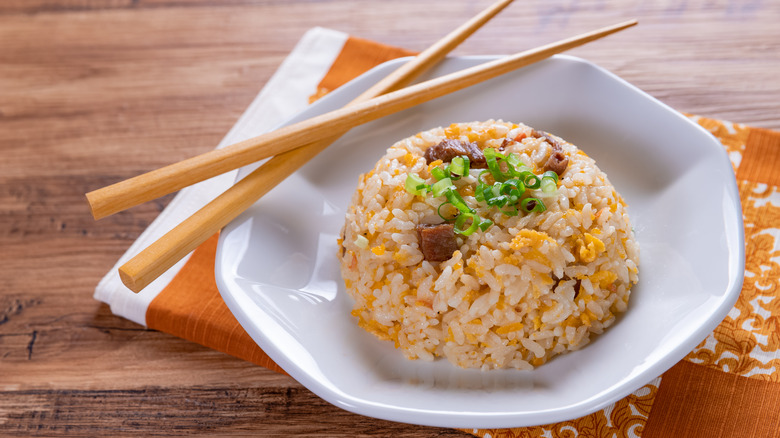Mirin Is The Secret Ingredient Your Fried Rice Is Missing
Few dishes are as beloved across the globe as fried rice, invented centuries ago in China. Today, fried rice is a staple, with variations like spicy kimchi fried rice and bacon-laden versions gracing our tables. We all know soy sauce and MSG play a role in making delicious fried rice, but did you know a secret ingredient hailing from Japan can elevate your homemade fried rice? And that ingredient, while it might not be in your pantry yet, is mirin.
What is mirin? It is a Japanese fermented rice wine, historically used for sipping, and now primarily used in cooking as a seasoning or condiment. It tastes like a syrupy, sweet sake with just a hint of tang. These days, you can easily find mirin in supermarkets, Asian specialty stores, and through online grocery shopping.
Now, what happens when you add mirin to fried rice? A splash of mirin introduces a subtle sweetness that can balance all the savory flavors in the dish, whether you're using salted egg yolk, lap cheong (or Chinese dried sausage), or diced bacon. Asian cooking is all about balancing and layering flavors, and you're doing just that by rounding out all the savory notes in the fried rice with mirin. As mirin also has alcohol, when heated, the alcohol evaporates quickly; thus, adding mirin does not make your fried rice unappealing wet, or soggy. Additionally, thanks to its fermentation process, mirin brings hints of umami.
Adding mirin to your fried rice is all about balancing and enhancing flavors
Convinced and ready to elevate your next batch of fried rice with mirin? If you don't know where to begin, start with Tasting Table recipe developer Catherine Brookes' chicken fried rice recipe. When making Brookes' recipe, incorporate mirin after cooking the chicken and while sauteeing the vegetables. The mirin will not only deglaze the pan, picking up the savory bits left by the chicken, but it will also impart a gentle, sweet undertone to the pan-fried vegetables.
Of course, you can always add mirin directly to the rice as you're frying the rice. This would be akin to adding salt, soy sauce, or MSG. Drizzle a tablespoon on top of the rice, taste it, adjust to your taste, and then go from there. The key to using mirin, and any seasoning, as a matter of fact, is finding balance while enhancing flavors. You want to add just enough mirin to complement the other flavors in the fried rice without overpowering them. If you've ever felt your fried rice is missing a touch of flavor, add this new secret ingredient we've uncovered for you: mirin.

